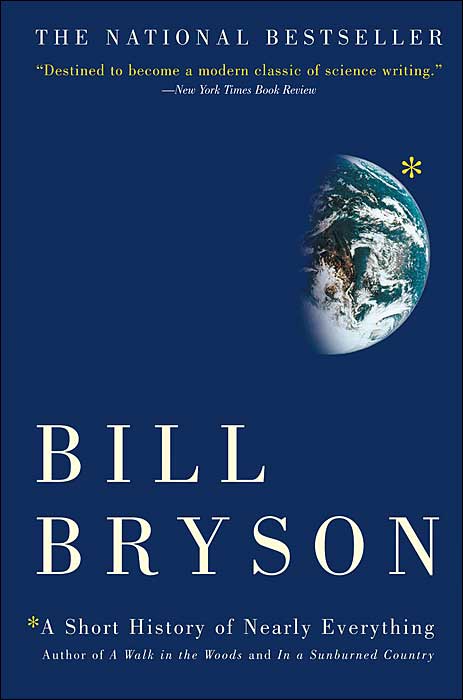“Good-Bye To All That”
For about a week since, I have been reading this really mind-opening book called “A Short History of Nearly Everything.” by Bill Bryson. At first, I thought the author was joking about the title—how could you explain everything about Earth’s history and how we come in form in one book? I’m no scientist or geologist myself so I thought it’d be rather difficult reading this book but it’s surprisingly not. The sentences aren’t laden with all the technical words and the author did his best to give a brief background on each scientist that contributed to the history of Earth and us.
As I read through the book, I realize that this is not just a literary book but also a textbook cuz it has a lot of information with tons of theories, explanations, and names. It’s 100 times better than any science textbooks I’ve ever read in middle school or high school. In fact, the author criticized a lot about textbooks we used in secondary education. They were either already outdated or some theories were misinterpreted as proved by recent scientists. Anyway, back to the topic, I read a cool paragraph that summarized everything about Earth’s history. Imagine, Earth’s history in a single paragraph? Could you write like that? Bill Bryson did. Here’s the vivid paragraph.
“If you imagine the 4.5 billion odd years of Earth’s history compressed into a normal earthy day, then life begins very early, about 4 a.m. with the rise of the first simple, single-celled organisms, but then advances no further for the next sixteen hours. Not until almost 8:30 in the evening, with the day five-sixths over, has Earth anything to show the universe but a restless skin of microbes. Then, finally, the first sea plants appear, followed twenty minutes later by the first jellyfish, and the engimatic Ediacaran fauna first seen by Reginald Sprigg in Australia. At 9:04 pm, trilobites swim onto the scene, followed more or less immediately by the shapely creatures of the Burgess Shale. Just before 10 pm, plants begin to pop up on the land. Soon after, with less than two hours left in the day, the first land creatures follow.
Thanks to ten minutes or so of balmy weather, by 10:24 pm the Earth is covered in the great carboniferous forests whose residues give us all our coal, and the first winged insects are evident. Dinosaurs plod onto the scence just before 11 pm and hold sway for about three-quarters of an hour. At twenty-one minutes to midnight they vanish and the age of mammals begins. Humans emerge one minute and seventeen seconds before midnight. The whole of our recorded history, on this scale, would be no more than a few seconds, a single human lifetime barely an instant. ” pp. 337
Ok ok, so it’s not one but two paragraphs–close enough but what about this next paragraph?
“Perhaps an even more effective way of grasping our extreme recentness as a part of this 4.5 billion-year old picture is to stretch your arms to their fullest extent and imagine that width as the entire history of the Earth. On this scale, according to John McPhee in Basin and Range, the distance from the fingertips of one hand to the wrist of the other is Precambrian. All of complex life is in one hand, “and in a single stroke with a medium-grained nail file you could eradicate human history.”
There you go, you have the entire Earth’s history right across your extended arms. Isn’t that better than what we were reading in HS science textbooks?
Before you start thinking about becoming 100 years old, our existence in Earth’s history is very SMALL, no more than a few seconds into Earth’s modified 24 hour history and can be easily wiped off with a nail file. Bill Bryson says that one certain thing about life is that it goes extinct. Nobody knows when but we all will become extinct. So, what do you do? Focus not on the length of your life but the width of your life. Try to make your life as wide as you can and you shall die a rich, fulfilling life. :-)
Before I end this post, average species last 4 million years. :-)
